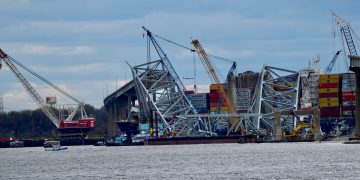The National Transportation Safety Board (NTSB) has released an investigation report on an incident where, , an engine room fire broke out aboard the passenger ferry Sandy Ground, while the vessel was underway in New York Harbor, near Staten Island, New York, with 884 persons aboard.
The incident
On December 22, 2022, about 1654 local time, an engine room fire broke out aboard the passenger ferry Sandy Ground, while the vessel was underway in Anchorage Channel, New York Harbor, near Staten Island, New York, with 884 persons aboard.1 The crew extinguished the fire by activating the
engine room’s fixed fire extinguishing system. The vessel lost propulsion and electricity, and the crew deployed both anchors. The majority of the passengers transferred to responding Good Samaritan vessels; the Sandy Ground was towed to the St. George Ferry Terminal in Staten Island, where the remaining persons on board disembarked. There were no injuries, and no pollution was reported. Damage to the vessel was estimated at $12.7 million.
There were no injuries. Two crewmembers reported smoke inhalation; they were transported to a local hospital and later released.
Damage
After the vessel returned to the dock and the engine room was cleared for safe entry, Staten Island Ferry management, technicians, Sandy Ground crewmembers, and Coast Guard and National Transportation Safety Board (NTSB) investigators examined the damaged areas of the engine room. They found the engine-mounted secondary spin-on duplex fuel filter assemblies that had been in service (online) at the time of the casualty on all four main engines were each distorted at the connection points where the filters sealed against the filter bases. The gasket on the no. 1 main engine secondary spin-on duplex engine-mounted secondary fuel filter had ruptured and protruded out of the sealing surface in the direction (outboard) of the no. 2 main engine.
Conclusions
Findings
- None of the following were factors during the casualty transit: (1) alcohol or other drug use by the crew; (2) weather and waterway conditions at the time
the fire broke out; or (3) impairment of the chief engineer or two oilers due to fatigue. - The on-duty engineering crewmembers’ ineffective engine room resource management resulted in a sharp increase in the difference in levels between
the two fuel oil day tanks. - In their ongoing response to correct the divergence in the Sandy Ground’s fuel oil day tank levels, the on-duty oilers closed both the port and starboard day tank fuel oil return isolation ball valves, causing the fuel oil system to overpressurize and, subsequently, the secondary duplex fuel oil filters to
rupture. - The engine room fire started when fuel oil sprayed from the ruptured secondary duplex fuel oil filter of the no. 1 main engine onto the no. 2 main
engine’s exhaust manifold and ignited. - The delay in shutting down the main engines led to pressurized fuel oil continuing to spray from the ruptured secondary duplex fuel oil filters after the
fire broke out, thereby feeding and increasing the severity of the fire. - The engineering crewmembers on duty at the time of the casualty did not operate the fuel oil system in accordance with the operator’s written guidance,
which resulted in the system’s overpressurization. - Staten Island Ferry’s training program for engineering crewmembers assigned to Ollis-class ferries was inadequate because crewmembers had different
perceptions about how to balance the day tank fuel oil levels, and they did not receive follow-on instruction after isolation ball valves were installed in the fuel oil return system, which resulted in the overpressurization of the system on the day of the casualty. - Because Ollis-class vessels’ fuel oil return systems were designed without relief valves, unlike previous classes of Staten Island ferries, the Sandy Ground
engineering crewmembers on duty at the time of the fire likely had an expectation that the fuel oil system could not be over pressurized. - Had the Sandy Ground fuel oil system been equipped with either a pressure relief valve installed in the fuel oil return line or an independent return line from the main engines’ fuel oil manifold block relief valves to a tank, the elevated fuel oil pressure caused by the closed fuel oil return isolation ball valves would have been relieved and a fuel oil system overpressurization would have been prevented.
- Despite the vessel’s fuel oil system complying with US Coast Guard regulations and American Bureau of Shipping rules, the presence of fuel oil return isolation ball valves in the Sandy Ground’s diesel engine fuel oil return system allowed for return flow to be blocked and the system to overpressurize.
- Explicit requirements and guidance for maintaining an unimpeded return flow in diesel engine fuel oil return systems supplied by positive displacement fuel oil pumps, including the installation of a pressure relief valve with unimpeded return to a service tank, would mitigate the risk of a system overpressurization and engine room fire.
- Other classification societies would benefit from learning about the circumstances of the engine room fire on board the Sandy Ground in order to share that information with their members so that future vessel designs provide for unimpeded return fuel oil flow.
- Specific guidance on maintaining unimpeded diesel engine fuel oil return flow would provide naval architects and engineers with additional information for the safe design of these systems.
- The Sandy Ground crew’s actions, combined with the quick response by nearby Good Samaritan vessels, resulted in a timely and safe evacuation of all persons on board.
Probable Cause
The National Transportation Safety Board determines that the probable cause of the engine room fire aboard the passenger ferry Sandy Ground was the design of the vessel’s diesel engine fuel oil return system, which included isolation valves that could be regularly adjusted by the crew and, when closed, stopped return fuel oil flow from all operating engines, resulting in the overpressurization of the fuel oil system and the ignition of fuel oil spraying from ruptured fuel oil filters onto the exhaust manifold of a running engine. Contributing to the overpressurization was the operator’s inadequate training program on fuel oil system operation, which did not provide follow-on instruction after the installation of fuel oil return isolation valves at the day tanks.
Recommendations
As a result of this investigation, the National Transportation Safety Board makes the following new safety recommendations.
To the US Coast Guard:
Revise Title 46 Code of Federal Regulations Chapter I, Subchapter F to require new construction diesel engine fuel oil return systems supplied by positive displacement fuel oil pumps to be designed to have an unimpeded return flow from the engine to a vented tank, or, if the vessel design requires isolation
valves in the fuel oil return line, other arrangements to prevent overpressurization. (M-24-5) Pending the implementation of a regulatory requirement,
develop design guidance for new-construction diesel engine fuel oil return systems supplied by positive displacement fuel oil pumps so they have unimpeded return flow from the engine to a vented tank, or, if the vessel design requires isolation valves in the fuel oil return line, other arrangements to prevent
overpressurization, and disseminate this guidance to the US Coast Guard Marine Safety Center. (M-24-6) Share Safety Alert-094 with marine inspectors so they can ensure existing vessels with diesel engine fuel oil systems supplied by positive displacement fuel pumps have unimpeded return flow to prevent overpressurization. (M-24-7)
To the American Bureau of Shipping:
Ensure your fuel oil piping rules used to class vessels require new construction diesel engine fuel oil systems supplied by positive displacement fuel oil pumps be designed to have unimpeded return flow from any single or multiple consumers to a vented tank, or, if the vessel design requires isolation valves in the fuel
oil return line, other arrangements to prevent overpressurization. (M-24-8).































































